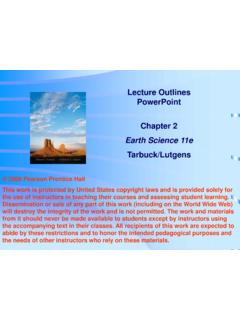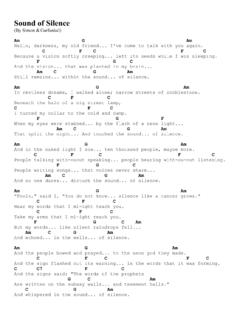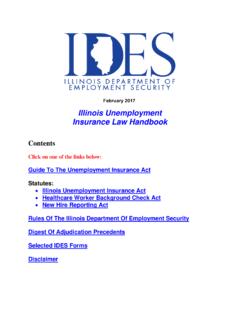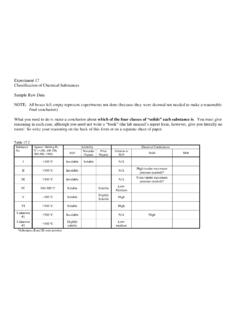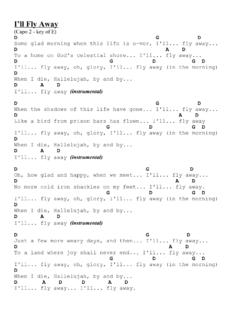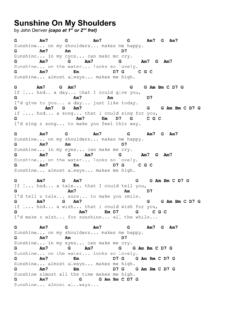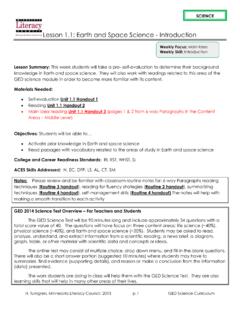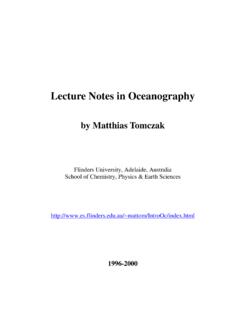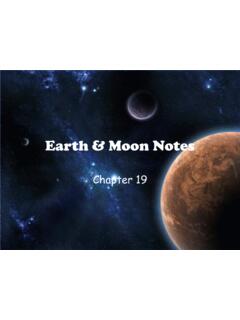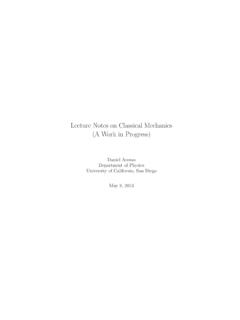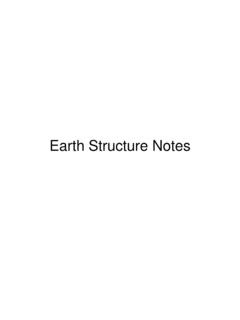Transcription of Lecture Outlines PowerPoint Chapter 18 Tarbuck/Lutgens
1 earth Science, 11eAir Pressure and WindChapter 18 Atmospheric pressure Force exerted by the weight of the air above Weight of the air at sea level pounds per square inch 1 kilogram per square centimeter Decreases with increasing altitude Units of measurement Millibar(mb) standard sea level pressure is mb Atmospheric pressure Units of measurement Inches of mercury standard sea level pressure is inches of mercury Instruments for measuring Barometer Mercury barometer Invented by Torricelli in 1643 Uses a glass tube filled with mercury A mercury barometerFigure pressure Instruments for measuring Barometer Aneroid barometer "Without liquid" Uses an expanding chamber Barograph(continuously records the air pressure)
2 Aneroid barometerFigure recording aneroid barometerFigure Horizontal movement of air Out of areas of high pressure Into areas of low pressure Controls of wind Pressure gradient force Isobars lines of equal air pressure Pressure gradient pressure change over distance A weather map showing isobars and wind speed/directionFigure Controls of wind Coriolis effect Apparent deflection in the wind direction due to earth 's rotation Deflection is to the right in the Northern Hemisphere and to the left in the Southern Hemisphere Friction Only important near the surface Acts to slow the air's movement The Coriolis effectFigure Upper air winds Generally blow parallel to isobars called geostrophic winds Jet stream "River" of air High altitude High velocity (120-240) kilometers per hour The geostrophic windFigure between upper-level winds and surface windsFigure and anticyclones Cyclone A center of low pressure Pressure decreases toward the center Winds associated with a cyclone In the Northern Hemisphere Inward (convergence) Counterclockwise In the Southern Hemisphere Inward (convergence) Clockwise Cyclones and anticyclones Cyclone Associated with rising air Often bring clouds and precipitation Anticyclone A center of high pressure Pressure increases toward the centerCyclones and anticyclones Anticyclone Winds associated with an anticyclone In the Northern Hemisphere Outward (divergence)
3 Clockwise In the Southern Hemisphere Outward (divergence) Counterclockwise Associated with subsiding air Usually bring "fair" weather Cyclonic and anticyclonic winds in the Northern HemisphereFigure associated with surface cyclones and anticyclonesFigure atmospheric circulation Underlying cause is unequal surface heating On the rotating earth there are three pairs of atmospheric cells that redistribute the heat Idealized global circulation Equatorial low pressure zone Rising air Abundant precipitationGeneral atmospheric circulation Idealized global circulation Subtropical high pressure zone Subsiding, stable, dry air Near 30 degrees latitude Location of great deserts Air traveling equatorward from the subtropical high produces the trade winds Air traveling poleward from the subtropical high produces the westerly windsGeneral atmospheric circulation Idealized global circulation Subpolar low pressure zone Warm and cool winds interact Polar front an area of storms Polar high pressure zone Cold.
4 Subsiding air Air spreads equatorward and produces polar easterly winds Polar easterlies collide with the westerlies along the polar frontIdealized global circulation Figure atmospheric circulation Influence of continents Seasonal temperature differences disrupt the Global pressure patterns Global wind patterns Influence is most obvious in the Northern Hemisphere Monsoon Seasonal change in wind direction Average surface pressure and associated winds for JanuaryFigure AAverage surface pressure and associated winds for JulyFigure BGeneral atmospheric circulation Influence of continents Monsoon Occur over continents During warm months Air flows onto land Warm, moist air from the ocean Winter months Air flows off the land Dry, continental airCirculation in the mid-latitudes The zone of the westerlies Complex Air flow is interrupted by cyclones Cells move west to east in the Northern Hemisphere Create anticyclonic and cyclonic flow Paths of the cyclones and anticyclones are associated with the upper-level airflowLocal winds Produced from temperature differences Small scale winds Types Land and sea breezes Mountain and valley breezes Chinook and Santa Ana winds Illustration of a sea breeze and a land breezeFigure measurement Two basic measurements Direction Speed Direction Winds are labeled from where they originate ( , North wind blows from the north toward the south)
5 Instrument for measuring wind direction is the wind vane Wind measurement Direction Direction indicated by either Compass points (N, NE, etc.) Scale of 0 to 360 Prevailing wind comes more often from one direction Speed often measured with a cup anemometerWind measurement Changes in wind direction Associated with locations of Cyclones Anticyclones Often bring changes in Temperature Moisture conditions El Ni o and La Ni a El Ni o A countercurrent that flows southward along the coasts of Ecuador and Peru Warm Usually appears during the Christmas season Blocks upwelling of colder, nutrient-filled water, and anchovies starve from lack of food Strongest El Ni o events on record occurred between 1982-83 and 1997-98 El Ni o and La Ni a El Ni o 1997-98 event caused Heavy rains in Ecuador and Peru Ferocious storms in California Related to large-scale atmospheric circulation Pressure changed between the eastern and western Pacific called the Southern Oscillation Changes in trade winds creates a major change in the equatorial current system.
6 With warm water flowing eastward Normal conditionsFigure AEl Ni oFigure BEl Ni o and La Ni a El Ni o Effects are highly variable depending in part on the temperatures and size of the warm water pools El Ni o and La Ni a La Ni a Opposite of El Ni o Triggered by colder than average surface temperatures in the eastern Pacific Typical La Ni a winter Blows colder than normal air over the Pacific Northwest and northern Great Plains while warming much of the rest of the United States Greater precipitation is expected in the Northwest El Ni o and La Ni a Events associated with El Ni o and La Ni a are now understood to have a significant influence on the state of weather and climate almost everywhere Global distribution of precipitation Relatively complex pattern Related to global wind and pressure patterns High pressure regions Subsiding air Divergent winds Dry conditions , Sahara and Kalahari deserts Global distribution of precipitation Related to global wind and pressure patterns Low pressure regions Ascending air Converging winds Ample precipitation.
7 Amazon and Congo basins Average annual precipitation in millimetersFigure distribution of precipitation Related to distribution of land and water Large landmasses in the middle latitudes often have less precipitation toward their centers Mountain barriers also alter precipitation patterns Windward slopes receive abundant rainfall from orographic lifting Leeward slopes are usually deficient in moisture End of Chapter 18
